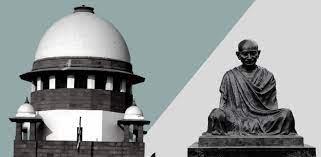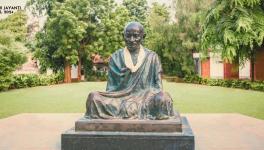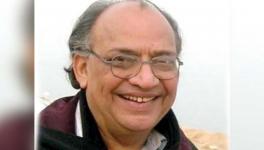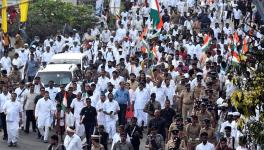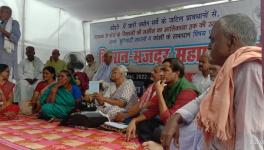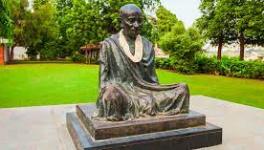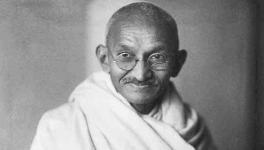What needs to be protected is Bapu’s legacy, his ideology and his bequest.
———–
Sabarmati Ashram is not only a monument to Bapu and Ba. It is a monument to Satyagraha, our unique non-violent mass movement for freedom. The soul and spirit of satyagraha resides at Sabarmati Ashram, and continues to inspire people the world over to fight for right and never to succumb to might.
The philosophy and ideology governing Bapu’s life and the life at the Ashram was based on the ideals of simplicity, frugality and minimal consumption. Today these principles are very difficult to believe. When one visits Sabarmati Ashram, its stark simplicity, frugality and minimal consumption become starkly evident. Hriday Kunj, Ba and Bapu’s humble abode at the Ashram, is a living example of simplicity, frugality and minimal consumption. It must be preserved in the same manner as must the entire precinct of the Sabarmati Ashram.
Also read: Tushar Gandhi, Mahatma’s great grandson, challenges Gandhi Ashram redevelopment before Guj HC
History of the Sabarmati Ashram
It was between 1917 and 1926 that Bapu purchased land parcels on the bank of the Sabarmati River, across from the city of Ahmedabad, with the intention of establishing an Ashram there. He wished to live away from the city community and wanted to establish a self-reliant community of Ashramites on the lines of his Ashrams in South Africa — Phoenix and Tolstoy Ashrams. He ended up purchasing almost 120 acres of land, some registered in his name and some in the name of his nephew, Khushaldas Gandhi. They then formed a trust called ‘The Sabarmati Ashram Trust’, and became signatories to its deed and registration. The property, all 120 acres of it, was transferred to the trust.
Hriday Kunj, Ba and Bapu’s humble abode at the Ashram, is a living example of simplicity, frugality and minimal consumption. It must be preserved in the same manner as must the entire precinct of the Sabarmati Ashram.
Bapu went to Champaran from here to fight for the rights of the poor and persecuted farmers there. He joined Sardar Patel, who was leading the farmer’s protest, for the Bardoli satyagraha, while staying at Sabarmati Ashram. The protests against the Rowlatt Act began from here, the Non Cooperation movement was launched from here and Sabarmati Ashram became its nerve centre.
Bapu was arrested and tried for sedition against the crown from Sabarmati Ashram and sentenced to six years imprisonment.
In 1930, Bapu began the Dandi Kooch from here and pledged not to return to the Ashram till he had won freedom for India. True to his pledge, he did not stay a night at the Ashram after 1930.
In 1933 he decided to surrender the Ashram to the colonial government as a protest against its brutal oppression and persecution of farmers and satyagrahis. Bapu decided that if anyone had to suffer for fighting for dignity, rights and freedom, as the first satyagrahi, he must; and so he decided to surrender the Ashram. He changed his mind after prolonged deliberations with his associates.
In 1933, Bapu took the decision that the ashram would be used for the upliftment of the “untouchables” and it should perpetually be utilised for their welfare. With this in mind, he had already formed the Harijan Sevak Sangh, so he handed over the Ashram to the Sangh’s president, Ghanshyamdas Birla with instructions that the organisation should utilise the Ashram to settle “untouchables”, and its activities must always be for their upliftment and welfare. To this he added a caveat: ‘those who were not untouchables but who confirmed the rules and ideals of the Ashram and wished to stay there must also be allowed to stay in the Ashram and its premises as long as they wish, thus turning the Ashram for the benefit of all communities and castes.
Also read: Gujarat High Court rejects Tushar Gandhi’s plea against redevelopment plans for Gandhi Ashram
These instructions have been the guiding principles of the Harijan Sevak Sangh and till now the Sabarmati Ashram has been utilised according to the final instructions of Bapu. His letter to Birla, therefore, must be considered to be his will and testament as far as the Sabarmati Ashram is concerned and adhered to in letter and spirit.
Bapu’s letter to Ghanshyamdas Birla, therefore, must be considered to be his will and testament as far as the Sabarmati Ashram is concerned and adhered to in letter and spirit.
When Bapu handed over the Ashram to the Harijan Sevak Sangh, he handed over the entire 120 acres of land. It was Bapu’s bequest. After independence and Bapu’s murder, the Harijan Sevak Sangh formed several organisations and trusts to continue to do the work of Bapu’s legacy and ideals, and parcels of Ashram land were allotted to them to do so efficiently. Much of the Ashram property was lost because of negligence, and now the land denoted as the Ashram is reduced to approximately 55 acres.
Recently, the Advocate General of Gujarat, appearing at the Gujarat High Court, claimed that the ‘Ashram’ is situated on a one acre plot, which he verbally assured the court will not be touched by the redevelopment project. This is an unacceptable argument. When one speaks of Bapu’s Ashram (Sabarmati Ashram in this case), it must be spoken of in its entirety as it existed during Bapu’s time, as a 120 acre entity with a great purpose and sanctity, even though the Ashram does not possess all the 120 acres of land at present day.
Redevelopment plan militates against Ashram’s foundational principles
Sabarmati has been a lot more than merely the home Ba and Bapu lived in. The world believes that it is where the fountain of greatness flows, and comes there to imbibe and be inspired by its spirit.
There are many other reasons to oppose the Government’s plans for the Ashram, such as the question of ownership of the land, purchased through individual initiative and vested in a registered trust, not owned by the government. So the government has no right to take over, change it or dictate terms. There are legally formed and run Trusts with competent (at least I hope they are) trustees who must be allowed to take decisions without interference and coercion from the government. They, and the larger community of Gandhians, must decide the fate of any Gandhi institution, organisation or memorial, definitely not the government.
After Bapu’s murder, an umbrella organisation was formed called Gandhi Smarak Nidhi, a national organisation entrusted with the duty of protecting, administering and propagating the Gandhi legacy, his ideology, and all the establishments associated with his life and his work. A founding principle of the Gandhi Smarak Nidhi was that it would insulate all Gandhi institutions, memorials, and Ashrams from government control and interference. Even the corpus of the Gandhi Smarak Nidhi, therefore, was collected from the public at large and donations from private individuals, not from the government.
The Sabarmati Redevelopment Project and its disproportionately large budget is contrary to this ethos too. Bapu would have never allowed Rs. 1,200 crores, that too belonging to the exchequer, to be spent on anything associated with him. I am certain he would have gone on a fast unto death against such a vulgar waste of people’s money.
Bapu would have never allowed Rs. 1,200 crores, that too belonging to the exchequer, to be spent on anything associated with him.
When the first cabinet of the interim government of India was sworn in, the ministers visited Bapu and asked for a message. The message Bapu gave to them then has now come to be known as Bapu’s Talisman: “I will give you a talisman: Whenever you are in doubt or when the self becomes too much with you; apply the following test: Recall the face of the poorest and the weakest man whom you may have seen, and ask yourself if the step you contemplate is going to be of any use to him, will he gain anything by it? Will it restore him to a control over his own life and destiny? In other words, will it lead to Swaraj for the hungry and spiritually starving millions? Then you will find your doubts and your self melting away.”
This message of Bapu is his legacy to humanity. Bapu also always spoke and worked for the service and benefit of those who he called ‘daridranarayan‘ or the impoverished deities. He believed that serving the last section of society, its poorest and weakest, was akin to the worship of God. Bapu dedicated his life to serving this section of humanity. His bequest of the Ashram, while ostensibly to serve the “untouchables”, also included the abjectly poor and their welfare.
Also read: Gandhi devised Satyagraha to usher in a just world order
Under the pretext of ‘redevelopment’ and creating facilities for visitors, many poor squatters who had been living in shanties across the road from the Ashram have been dispossessed, driven away without any compensation or alternate accommodation, their small inadequate dwellings demolished. Many of them had been living here for over two and three decades. Bapu would never have approved of this, definitely not in his name, on the excuse of making his Ashram ‘world class’.
These are some of the many issues, including environmental concerns that need to be considered while deciding the fate of the Sabarmati Ashram and the legacy of Mohandas Karamchand Gandhi – Bapu. But for me, what needs to be protected is Bapu’s legacy, his ideology and his bequest.
On April 5, 1930 Bapu wrote, “I want world sympathy in this battle of right against might.” This is my appeal to the Supreme Court of India.









